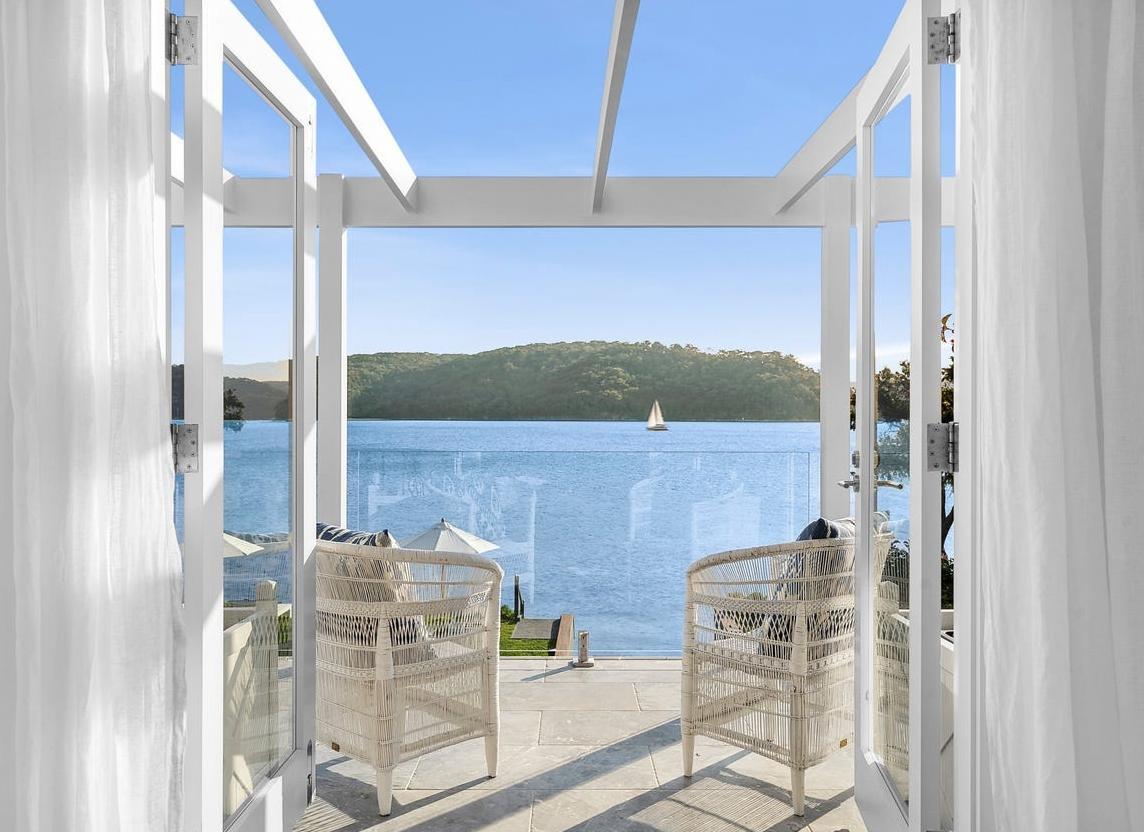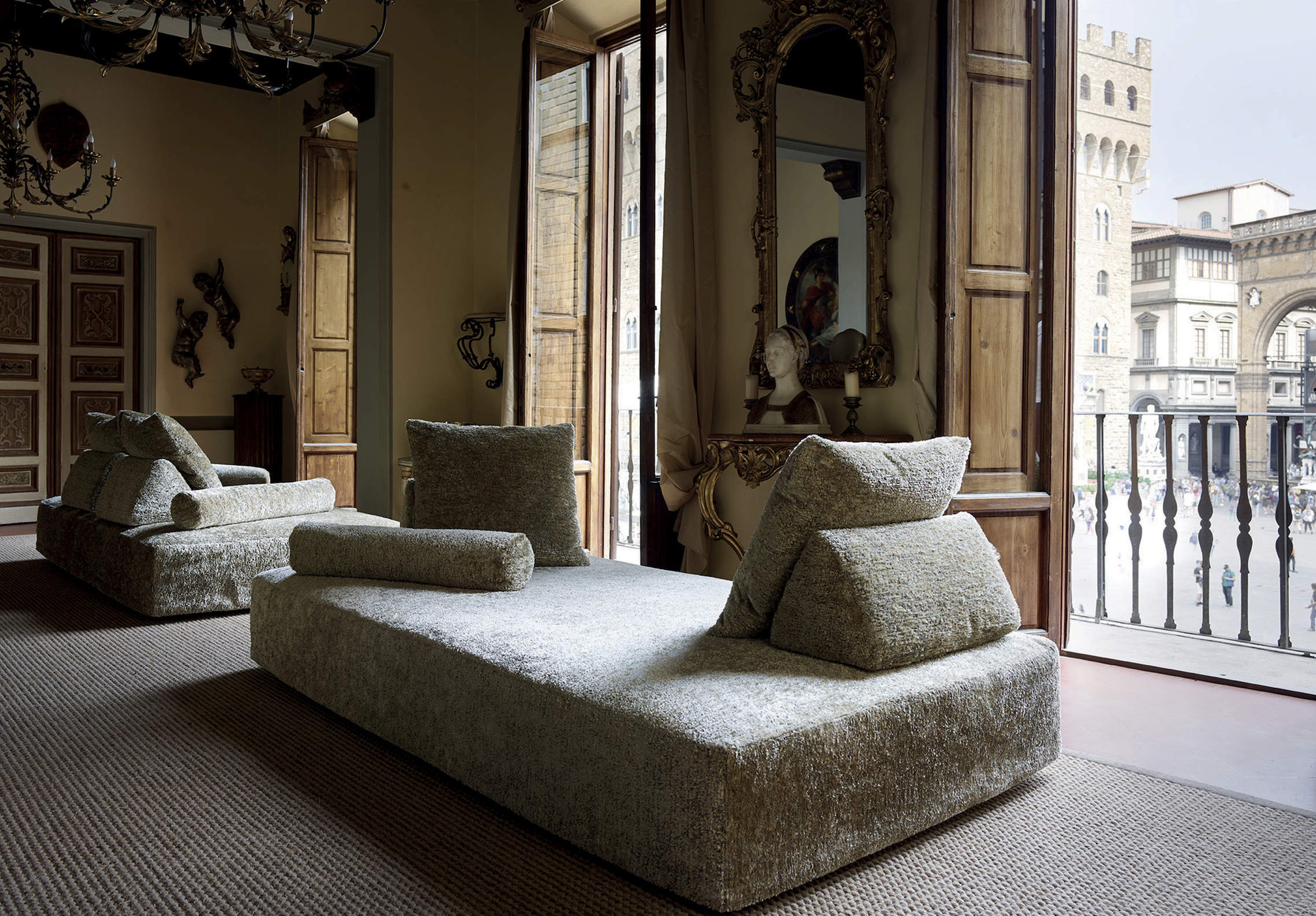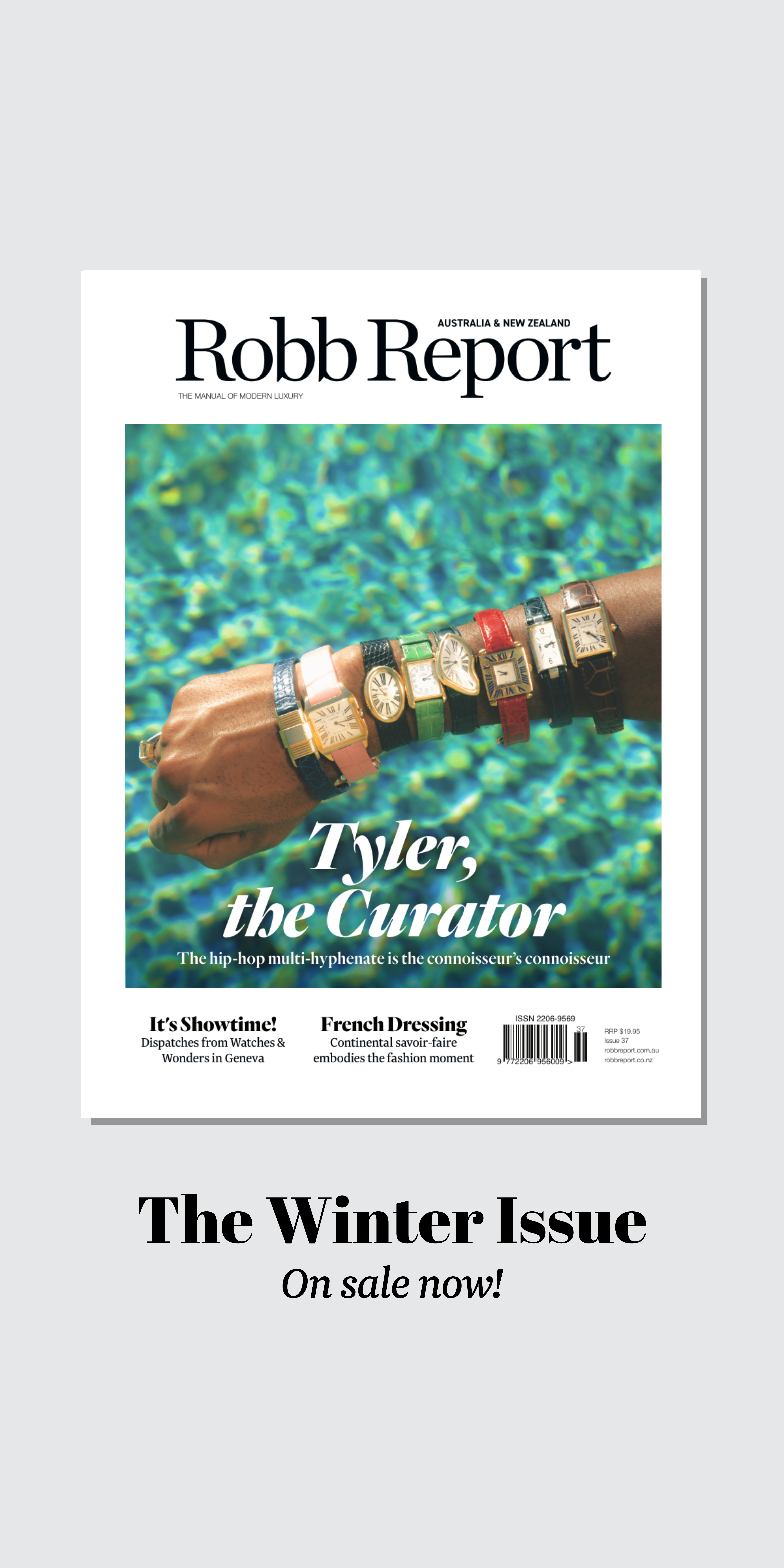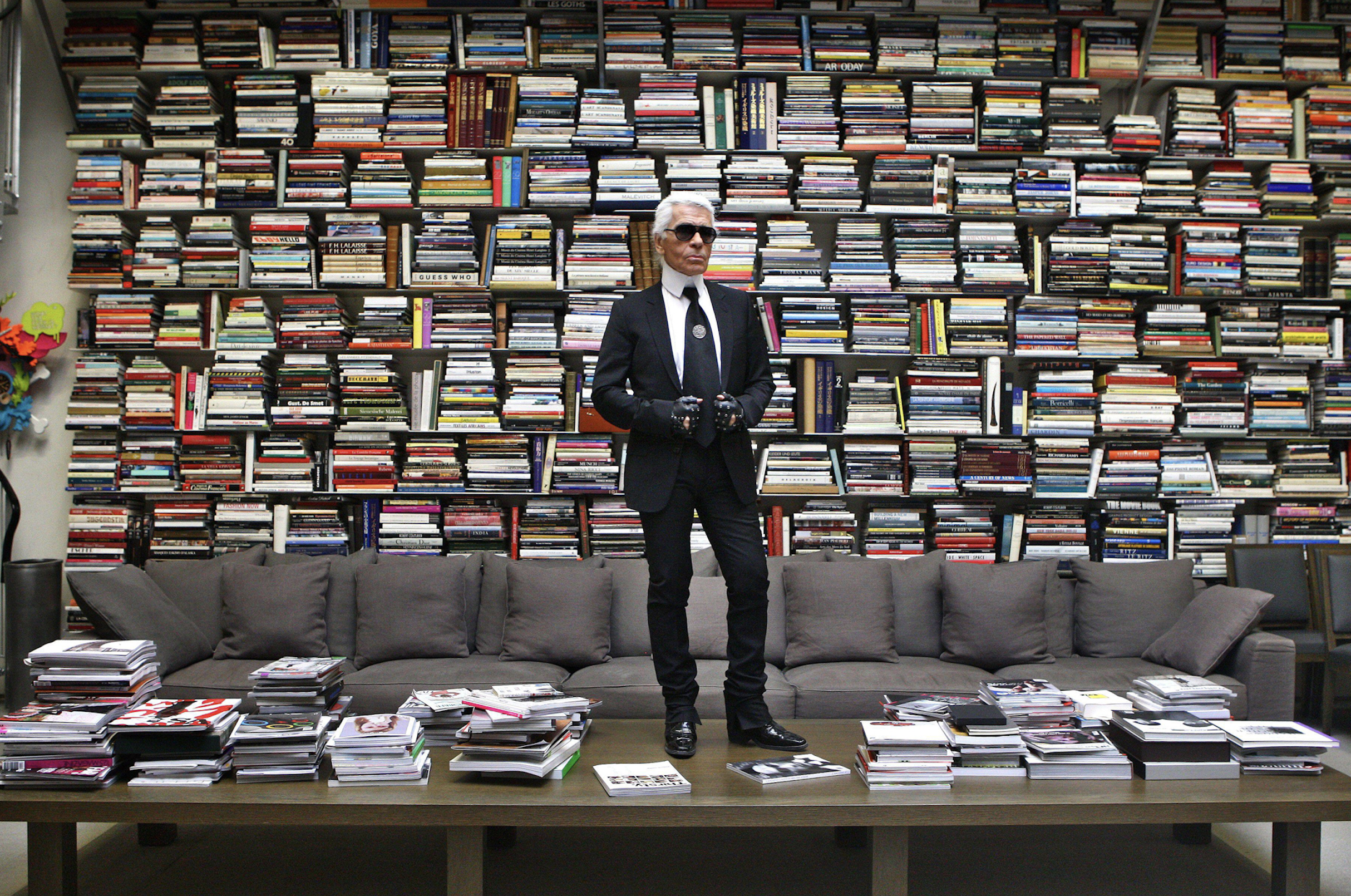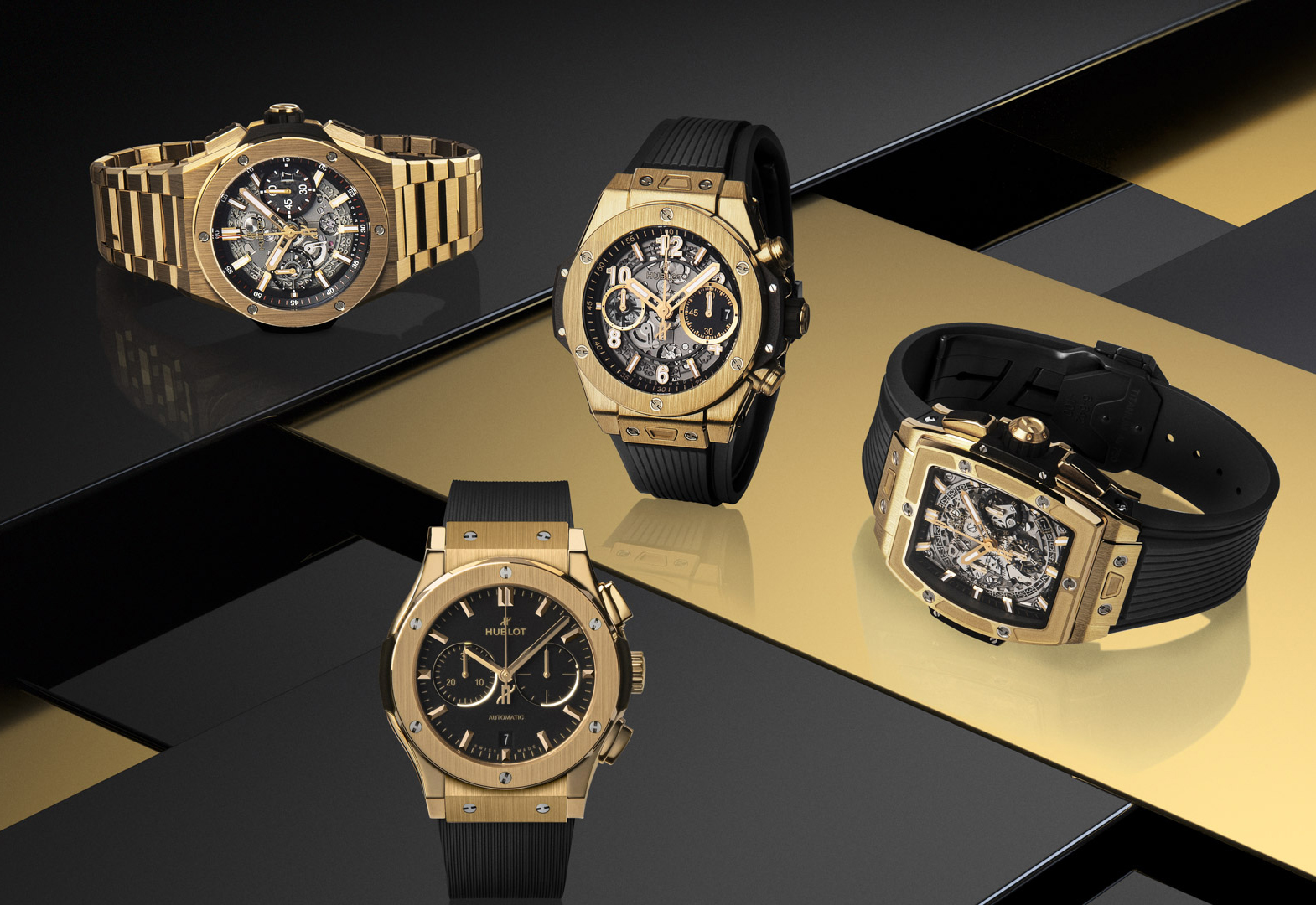
The Must-See Timepieces From LVMH Watch Week
Expect plenty of gold, serious movements and intricate dials.
Related articles
LVMH is back with a bang… well, sort of.
The company had originally planned to hold the kick-off for its Q1 watches in 2022 with a big in-person unveiling in Geneva this month, which got derailed due to the ongoing challenges of the pandemic. The company had hosted its first annual Watch Week in January of 2020 with a splashy event in Dubai, just before Covid-19 went global, which gave the company a bit of an unexpected leg up over its competitors who were forced to unveil watches later in the year over a series of Zoom press conferences. But, to accommodate the change of plans this year, the company showed watches in respective markets in lieu of a global gathering. The big trends are yellow-gold cases, slim-down profiles and movements and serious dial work. Here is a look at some of the highlights.
HUBLOT
Big Bang Integral Time Only

Hublot Big Bang Integral Time Only Hublot
The Big Bang trims its waistline. For the first time, the Big Bang Integral is being offered in a new 40mm size. Hublot watches have, traditionally, catered to pumped-up wrists in sizes up to 45mm. “In the ‘80s, our first watch, I believe, was 35mm and at that time that was a men’s watch,” Hublot CEO, Riccardo Guadalupe told Robb Report. “We went to 48 mm five or six years ago and I think we are going down heavily [in size].” Previous editions of the Big Bang Integral, however, came in 42mm but demand for more unisex-friendly watches has seen many brands begin offering models in reduced diameters. “We believe that we can sell this watch either to men or women,” Guadalupe, confirmed. “We believe that the ergonomics, the lightness and the size are quite important.” The new slim-fit look doesn’t just apply to its circumference; it is also the thinnest iteration at just 9.25-mm thick. The dial has also been scaled-back to a time-only layout versus its predecessor’s flyback chronograph movement. However, it features the same integrated bracelet as the original.
“Integral was really a big challenge, because as you know we are known for rubber straps and not bracelets,” said Guadalupe. “A year ago we launched the Big Bang Integral in 42mm in titanium, ceramic and rose gold. Since then, we have also developed new colours of ceramic. But we wanted the Integral to be a big pillar in our collection in the future.”
Three versions of the new 40mm Big Bang Integral are offered in an all-black ceramic, yellow-gold and titanium timepieces.
Price: All-black ceramic, $27,800, limited to 250; yellow gold, $68,800; titanium, $24,800.
Yellow Gold Collection

Hublot Yellow Gold Collection Hublot
Reminder: Gold is back, baby! Hublot is introducing the precious metal across all of its pillar collections including the above Big Bang Integral, the Big Bang Unico, the Classic Fusion Chronograph and the Spirit of Big Bang. “I was thinking about yellow gold for a few years, because it was really in fashion in the ‘80s and ‘90s,” Riccardo Guadalupe told Robb Report. “In 1980, when we came with our first Fusion [the Classic Original] watch it was in 18-carat gold with a rubber strap. So, I said to myself, ‘We should go back to those roots and come with a few models in yellow gold.’” It demonstrates a serious push for the alloy following several years of a steel rush and it’s refreshing. Guadalupe also nodded to the cyclical nature of fashion as an influence, rightly predicting the comeback of ’80s style which has already been reinvigorated on the runways.
“We will see what the market reaction will be, but sometimes it’s just a feeling and we want to be leaders of the trend that is going to happen,” he said. “Fashion always recycles and in fashion, the cycles are shorter, but in the watch industry it can be a 10- or 20-year cycle to come back to a material or another thing that has become fashionable again.” Guadalupe, however, opted for the titanium Big Bang Integral to wear on his wrist during our meeting. Nevertheless, we suspect his big bet on gold will be just in time for the next sartorial wave.
Price: Classic Fusion Chronograph ($37,400), Big Bang Integral ($73,200), Big Bang Unico ($51,200), Spirit of Big Bang ($56,500)
BULGARI
Octo Roma Blue Carillon Tourbillon

Bulgari Octo Roma Blue Carillon Tourbillon Bulgari
Bulgari focused primarily on its women’s collections for its Q1 introductions (see below), but its Octo Roma Carillon got a snazzy update with the introduction of a blue high-tech carbon-based coating on the movement and the circumference of the platinum case when viewed from the side. The company also added hour indexes and an Arabic numeral at 12 o’clock. While the new hue is certainly electrifying, the numerals distract from the modern architecture of the BVL428 calibre with cut-out bridges in an ALD treatment, as well as a perforated surface made of alternating polished steel. Nevertheless, it’s a serious complication piece featuring three gongs, visible on the dial side and attached directly to the body of the case, along with three openings on the side of the case for better sound amplification. The gongs are bent and formed by hand in several stages before being hardened at temperatures up to 1,652 degrees Fahrenheit before being cleaned and reheated in a 932-degree kiln, which gives the metal its superior sound. They are drawn out with a file in order to hone the chords of the chime. It plays note C for the hours; E, D and C for the quarters; and E for the minutes.
It features 75 hours of power reserve and houses 432 components in a movement measuring 25mm by 8.25mm. It’s a big watch, as is to be expected from this kind of timepiece, at 44 mm by 12.83 mm thick and comes with a matching blue alligator strap to highlight its new hue.
Price: Upon request, limited to 30.
Serpenti Piccolissimo

Bulgari Serpenti Misteriosi Bulgari
Talk about striking! Bulgari’s latest high-jewellery Serpenti Misteriosi timepieces, not surprisingly, are the most seductive women’s watches in the LVMH lineup. The Serpenti is so iconic it hardly needs an update, but this year the Italian house decided to equip the model with its other area of expertise—ultra-slim watchmaking. The new Piccolissimo (Italian for “very small”) BVL100 calibre is one of the smallest calibres in the world. The only other calibre to rival that claim is Jaeger-LeCoultre’s calibre 101, which is rectangular, unlike Bulgari’s spherical creation. Bulgari’s however takes the cake for the thinnest at 2.5mm versus JLC’s at 3.4mm.
It’s the company’s latest twist on extreme thinness, following a series of multiple world record’s in its Octo Finissimo line for men. And while the company already laid claim to the world’s thinnest tourbillon movement in the Serpenti Seduttori, Fabrizio Buonamassa Stigliani, Bulgari’s creative director and head of watch design, says it actually takes its cues from the ultra-thin movements of the Finissimo line and zero components were used from the Seduttori tourbillon. “The idea behind this movement was to elevate the Serpenti as the best of our know-how,” he said in a small group of journalists during a press conference Monday morning. He added that the company felt obliged to create the in-house movement for its high-jewellery Serpentis because, “These kind of pieces that cost a fortune, the idea to have a quartz movement starts to become something that is not interesting for this kind of market. Even the ladies would love to have a mechanical movement for these kinds of watches.”
While the movement is certainly the biggest news for the Serpenti, there have been other refinements including more details on the interior of the mouths from gem-setting to fine-finishing, as well as a slimmer body, neck and a flatter head. In fact, Buonamassa Stigliani says that it took 6 to 8 months just to perfect the shape of the case and head between the size, weight and movement. The entire design, including the movement, was three years in the works. Meanwhile, for the first time, the tongue of the snake operates as a lever to open the head and the interior watch can fully detach from the head for easier after-sales servicing, preventing damage to the jewellery structure. The patented crown, which can be found underneath the serpent’s lower jaw, features a bidirectional system (which does not require the crown to be pulled out) that sets the time in one direction and winds the watch in the other direction.
The new series is based on heritage examples of early Serpentis, including one that belonged to Elizabeth Taylor in the early ’60s (pictured below, left). That piece was mimicked in a white gold case and head set with 626 round brilliant-cut diamonds, 2 pear-cut emeralds, a diamond-paved dial, a yellow-gold double-tour bracelet with round brilliant-cut diamonds and a white-gold tail set with round brilliant-cut diamonds, which is the most expensive of the lot at approx. $383,000. Unlike the original, it features an immaculate invisible snow-setting of diamonds that carry through to the interior of the snake’s mouth and along the bezel of the timepiece inside.

Elizabeth Taylor’s 1961 Serpenti; A Heritage Serpenti from the Bulgari Archives Buglari
And while you really can’t go wrong with any Serpenti, least of all one that takes after a provenance piece owned by one of the most famous jewellery collectors in Hollywood history, the rose gold case set with brilliant-cut diamonds, turquoise inserts, a 2 pear-cut rubellites for the eyes is another clear standout—so beautiful, it’s downright sinful (approx. $351,000). Both this version and the one mentioned above also come with a faceted sapphire crystal dial cover for extra sparkle. The black (approx. $232,000) and emerald enamel (approx. $319,000) Serpentis are hand-engraved and feature flat, instead of faceted sapphire crystal covering the dials.

Buglari
Bulgari Serpenti Misteriosi
Needless to say, these are historic pieces, thanks to the introduction of a mechanical movement and a thoughtful redesign, and will be the must-have Serpentis to own for serious collectors (with six-figure price tags to match). While they will be small in production numbers they are, however, not technically limited.
Serpenti Tubogas

Bulgari Serpenti Tubogas Bulgari
The Serpenti Tubogas line went for gold this year in two single wrap Serpenti models in 18-carat yellow-gold model and two-tone steel and 18-carat yellow gold. The line had predominately focused on yellow-gold previously, although a double curved yellow-gold Tubogas did exist in the lineup and it is sold out. “Today, the yellow-gold trend is very, very strong,” said Buonamassa Stiglioni. “It’s massive. A few years ago it was just in some regions, but today we receive requests for yellow-gold from many countries.” Indeed, women have been flocking more towards yellow gold in recent years and the version above left likely won’t be available for long if the approx. $58,000 double strap version is already out of stock.
Price: Yellow gold, approx. $46,100; Two-tone, approx. $18,100
ZENITH
Defy Skyline

Zenith Defy Skyline Zenith
Following the limited-edition release of its Revival Defy A3642 heritage piece last week, Zenith homed in on dial design for its more accessible Defy Skyline range. Drawing inspiration from the night sky above the manufacture, just like its founder, Georges-Favre Jacot, did 157 years ago, the dial features an engraved star-studded texture in a sunburst finish set within an octagonal case, inspired by the earliest Defy from 1969 on which the Revival A3642 is based, and topped off with a 12-sided bezel.
Powered by the automatic El Primero 3620 movement, which takes cues from the El Primero 3600 1/10th of a second chronograph, the Defy Skyline collection features a 1/10th of a second hand, which beats at 5 HZ and comes with a stop-second mechanism for a precise setting of the time. The bi-directional rotor, visible through the caseback, has also been fashioned in a star motif and delivers 60 hours of power reserve.
The steel 41 mm watches will, no doubt, draw comparisons to Audemars Piguet’s icon—the Royal Oak, which is celebrating its 50th anniversary this year after its debut in 1972. But at $12,200 a pop, they are far more affordable, offering a similar look at a, relatively speaking, palatable price. And as an added bonus, you can also switch out the bracelet for a rubber strap, also adorned with star pattern, which is offered in blue and black to their corresponding dial colors or olive-green for the silver-dial version. All can be easily swapped without the use of tools thanks to a quick strap-change mechanism.
Price: $12,200
Defy Extreme Carbon

Zenith Defy Extreme Carbon Zenith
At 45 by 15.4mm this is the heftiest watch of Zenith’s 2022 debuts thus far. But it’s also incredibly light thanks to its layered carbon fibre case and marks the first time a Defy Extreme model has been made in the material. And, inside, it houses the fastest chronograph movement on the market with time measurements at 1/100th of a second and two escapements operating at 36,000 VpH (5Hz) for the hours and minutes and minutes at the chronograph function operating at 360,000 VpH (50 Hz). It’s a full package sports watch and the perfect mascot for the next season of Extreme E racing, of which Zenith is the official timekeeper, which will kick off this February with the Desert X Prix in Saudi Arabia. The partnership means you can expect more limited-edition Defy Extreme watches tied to the Extreme E races in the future.
The watch comes on a black leather strap with a titanium triple folding clasp but can be swapped out for a black velcro version or a red rubber strap. The latter will highlight the colourful dial markers including the 1/100th of a second chronograph scale in bright yellow, the chronograph counters in bright blue, green and white and hits of red in the power reserve indicator—all of which, naturally, mimic the colour schemes of the Extreme E’s “X Prix.”
Fortunately, you won’t have to race to your local AD to claim your stake on one as the Defy Extreme Carbon will not be a limited edition, giving you more time to deliberate on its five-figure price tag.
Price: $36,100
Subscribe to the Newsletter
Recommended for you
Watches & Wonders 2024 Showcase: Hermès
We head to Geneva for the Watches & Wonders exhibition; a week-long horological blockbuster featuring the hottest new drops, and no shortage of hype.
By Josh Bozin
July 24, 2024
Watch This Space: Mike Nouveau
Meet the game-changing horological influencers blazing a trail across social media—and doing things their own way.
By Josh Bozin
July 22, 2024
You may also like.
By Josh Bozin
24/07/2024
You may also like.
5 Lounge Chairs That Add Chic Seating to Your Space
Daybeds, the most relaxed of seating solutions, offer a surprising amount of utility.
Chaise longue, daybed, recamier, duchesse brisée—elongated furniture designed for relaxing has a roster of fancy names. While the French royal court of Louis XIV brought such pieces to prominence in fashionable European homes, the general idea has been around far longer: The Egyptian pharaohs were big fans, while daybeds from China’s Ming dynasty spurred all those Hollywood Regency fretwork pieces that still populate Palm Beach living rooms. Even Mies van der Rohe, one of design’s modernist icons, got into the lounge game with his Barcelona couch, a study of line and form that holds up today.
But don’t get caught up in who invented them, or what to call them. Instead, consider their versatility: Backless models are ideal in front of large expanses of glass (imagine lazing on one with an ocean view) or at the foot of a bed, while more structured pieces can transform any corner into a cozy reading nook. Daybeds may be inextricably linked to relaxation, but from a design perspective, they put in serious work.

Emmy, Egg Collective
In designing the Emmy chaise, the Egg Collective trio of Stephanie Beamer, Crystal Ellis and Hillary Petrie, who met as students at Washington University in St. Louis, aimed for versatility. Indeed, the tailored chaise looks equally at home in a glass skyscraper as it does in a turn-of-the-century town house. Combining the elegance of a smooth, solid oak or walnut frame with the comfort of bolsters and cushioned upholstery or leather, it works just as well against a wall or at the heart of a room. From around $7,015; Eggcollective.com
 Plum, Michael Robbins
Plum, Michael Robbins
Woodworker Michael Robbins is the quintessential artisan from New York State’s Hudson Valley in that both his materials and methods pay homage to the area. In fact, he describes his style as “honest, playful, elegant and reflective of the aesthetic of the Hudson Valley surroundings”. Robbins crafts his furniture by hand but allows the wood he uses to help guide the look of a piece. (The studio offers eight standard finishes.) The Plum daybed, brought to life at Robbins’s workshop, exhibits his signature modern rusticity injected with a hint of whimsy thanks to the simplicity of its geometric forms. Around $4,275; MichaelRobbins.com

Kimani, Reda Amalou Design
French architect and designer Reda Amalou acknowledges the challenge of creating standout seating given the number of iconic 20th-century examples already in existence. Still, he persists—and prevails. The Kimani, a bent slash of a daybed in a limited edition of eight pieces, makes a forceful statement. Its leather cushion features a rolled headrest and rhythmic channel stitching reminiscent of that found on the seats of ’70s cars; visually, these elements anchor the slender silhouette atop a patinated bronze base with a sure-handed single line. The result: a seamless contour for the body. Around $33,530; RedaAmalou
Dune, Workshop/APD
From a firm known for crafting subtle but luxurious architecture and interiors, Workshop/APD’s debut furniture collection is on point. Among its offerings is the leather-wrapped Dune daybed. With classical and Art Deco influences, its cylindrical bolsters are a tactile celebration, and the peek of the curved satin-brass base makes for a sensual surprise. Associate principal Andrew Kline notes that the daybed adeptly bridges two seating areas in a roomy living space or can sit, bench-style, at the foot of a bed. From $13,040; Workshop/ APD
Sherazade, Edra
Designed by Francesco Binfaré, this sculptural, minimalist daybed—inspired by the rugs used by Eastern civilizations—allows for complete relaxation. Strength combined with comfort is the name of the game here. The Sherazade’s structure is made from light but sturdy honeycomb wood, while next-gen Gellyfoam and synthetic wadding aid repose. True to Edra’s amorphous design codes, it can switch configurations depending on the user’s mood or needs; for example, the accompanying extra pillows—one rectangular and one cylinder shaped— interchange to become armrests or backrests. From $32,900; Edra
You may also like.
By Josh Bozin
24/07/2024
22/07/2024
Watches & Wonders 2024 Showcase: Hermès
We head to Geneva for the Watches & Wonders exhibition; a week-long horological blockbuster featuring the hottest new drops, and no shortage of hype.
With Watches & Wonders 2024 well and truly behind us, we review some of the novelties Hermès presented at this year’s event.
—
HERMÈS

Moving away from the block colours and sporty aesthetic that has defined Hermès watches in recent years, the biggest news from the French luxury goods company at Watches & Wonders came with the unveiling of its newest collection, the Hermès Cut.
It flaunts a round bezel, but the case middle is nearer to a tonneau shape—a relatively simple design that, despite attracting flak from some watch aficionados, works. While marketed as a “women’s watch”, the Cut has universal appeal thanks to its elegant package and proportions. It moves away from the Maison’s penchant for a style-first product; it’s a watch that tells the time, not a fashion accessory with the ability to tell the time.
Hermès gets the proportions just right thanks to a satin-brushed and polished 36 mm case, PVD-treated Arabic numerals, and clean-cut edges that further accentuate its character. One of the key design elements is the positioning of the crown, boldly sitting at half-past one and embellished with a lacquered or engraved “H”, clearly stamping its originality. The watch is powered by a Hermès Manufacture movement H1912, revealed through its sapphire crystal caseback. In addition to its seamlessly integrated and easy-wearing metal bracelet, the Cut also comes with the option for a range of coloured rubber straps. Together with its clever interchangeable system, it’s a cinch to swap out its look.
It will be interesting to see how the Hermès Cut fares in coming months, particularly as it tries to establish its own identity separate from the more aggressive, but widely popular, Ho8 collection. Either way, the company is now a serious part of the dialogue around the concept of time.
—
Read more about this year’s Watches & Wonders exhibition at robbreport.com.au
You may also like.
22/07/2024
Living La Vida Lagerfeld
The world remembers him for fashion. But as a new tome reveals, the iconoclastic designer is defined as much by extravagant, often fantastical, homes as he is clothes.
“Lives, like novels, are made up of chapters”, the world-renowned bibliophile, Karl Lagerfeld, once observed.
Were a psychological-style novel ever to be written about Karl Lagerfeld’s life, it would no doubt give less narrative weight to the story of his reinvigoration of staid fashion houses like Chloe, Fendi and Chanel than to the underpinning leitmotif of the designer’s constant reinvention of himself.
In a lifetime spanning two centuries, Lagerfeld made and dropped an ever-changing parade of close friends, muses, collaborators and ambiguous lovers, as easily as he changed his clothes, his furniture… even his body. Each chapter of this book would be set against the backdrop of one of his series of apartments, houses and villas, whose often wildly divergent but always ultra-luxurious décor reflected the ever-evolving personas of this compulsively public but ultimately enigmatic man.
With the publication of Karl Lagerfeld: A Life in Houses these wildly disparate but always exquisite interiors are presented for the first time together as a chronological body of work. The book indeed serves as a kind of visual novel, documenting the domestic dreamscapes in which the iconic designer played out his many lives, while also making a strong case that Lagerfeld’s impact on contemporary interior design is just as important, if not more so, than his influence on fashion.
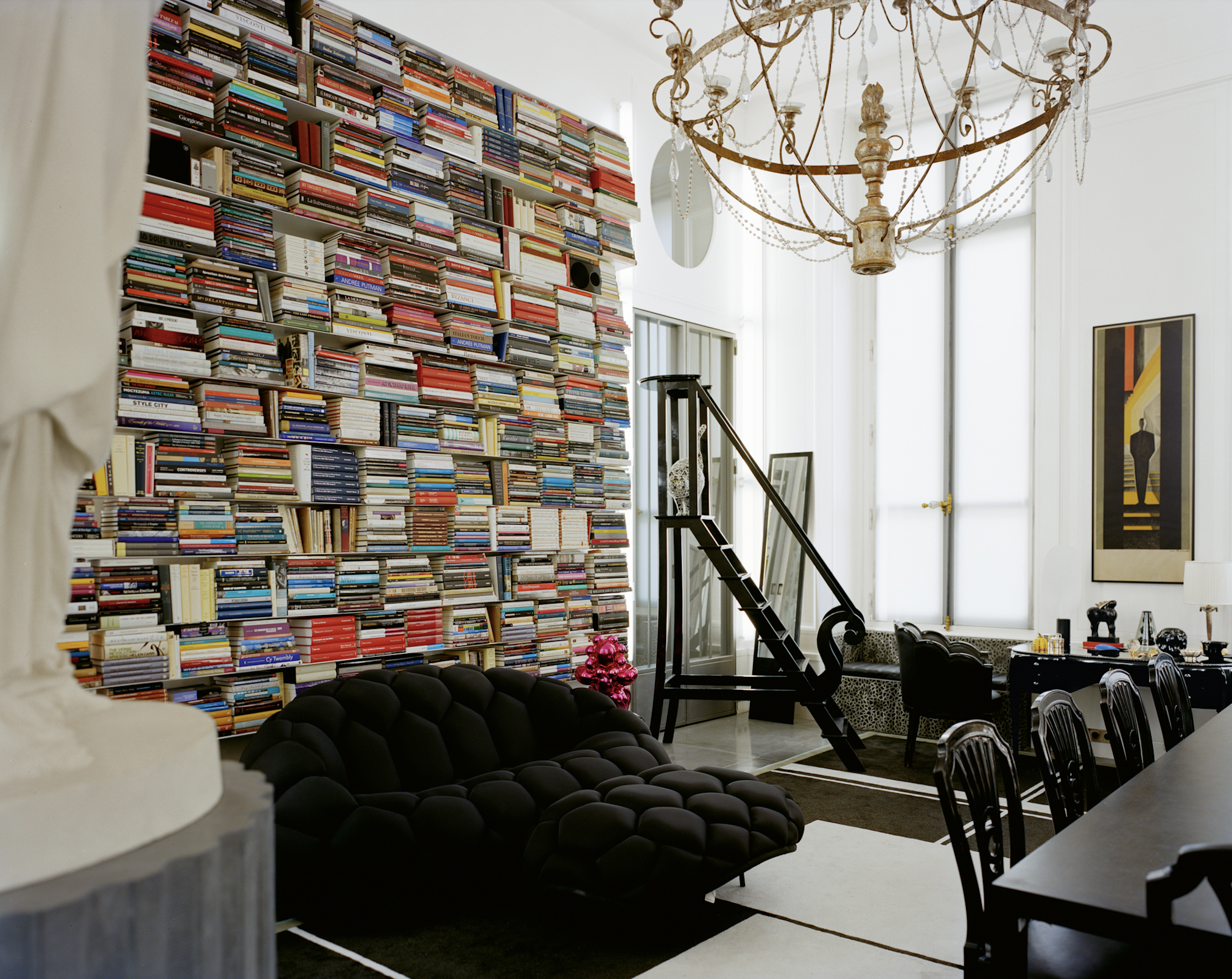
In fact, when the first Lagerfeld interior was featured in a 1968 spread for L’OEil magazine, the editorial describes him merely as a “stylist”. The photographs of the apartment in an 18th-century mansion on rue de Université, show walls lined with plum-coloured rice paper, or lacquered deepest chocolate brown in sharp contrast to crisp, white low ceilings that accentuated the horizontality that was fashionable among the extremely fashionable at the time. Yet amid this setting of aggressively au courant modernism, the anachronistic pops of Art Nouveau and Art Deco objects foreshadow the young Karl’s innate gift for creating strikingly original environments whose harmony is achieved through the deft interplay of contrasting styles and contexts.
Lagerfeld learned early on that presenting himself in a succession of gem-like domestic settings was good for crafting his image. But Lagerfeld’s houses not only provided him with publicity, they also gave him an excuse to indulge in his greatest passion. Shopping!
By 1973, Lagerfeld was living in a new apartment at Place Saint–Sulpice where his acquisition of important Art Deco treasures continued unabated. Now a bearded and muscular disco dandy, he could most often be found in the louche company of the models, starlets and assorted hedonistic beauties that gathered around the flamboyant fashion illustrator Antonio Lopez. Lagerfeld was also in the throes of a hopeless love affair with Jacques de Bascher whose favours he reluctantly shared with his nemesis Yves Saint Laurent.
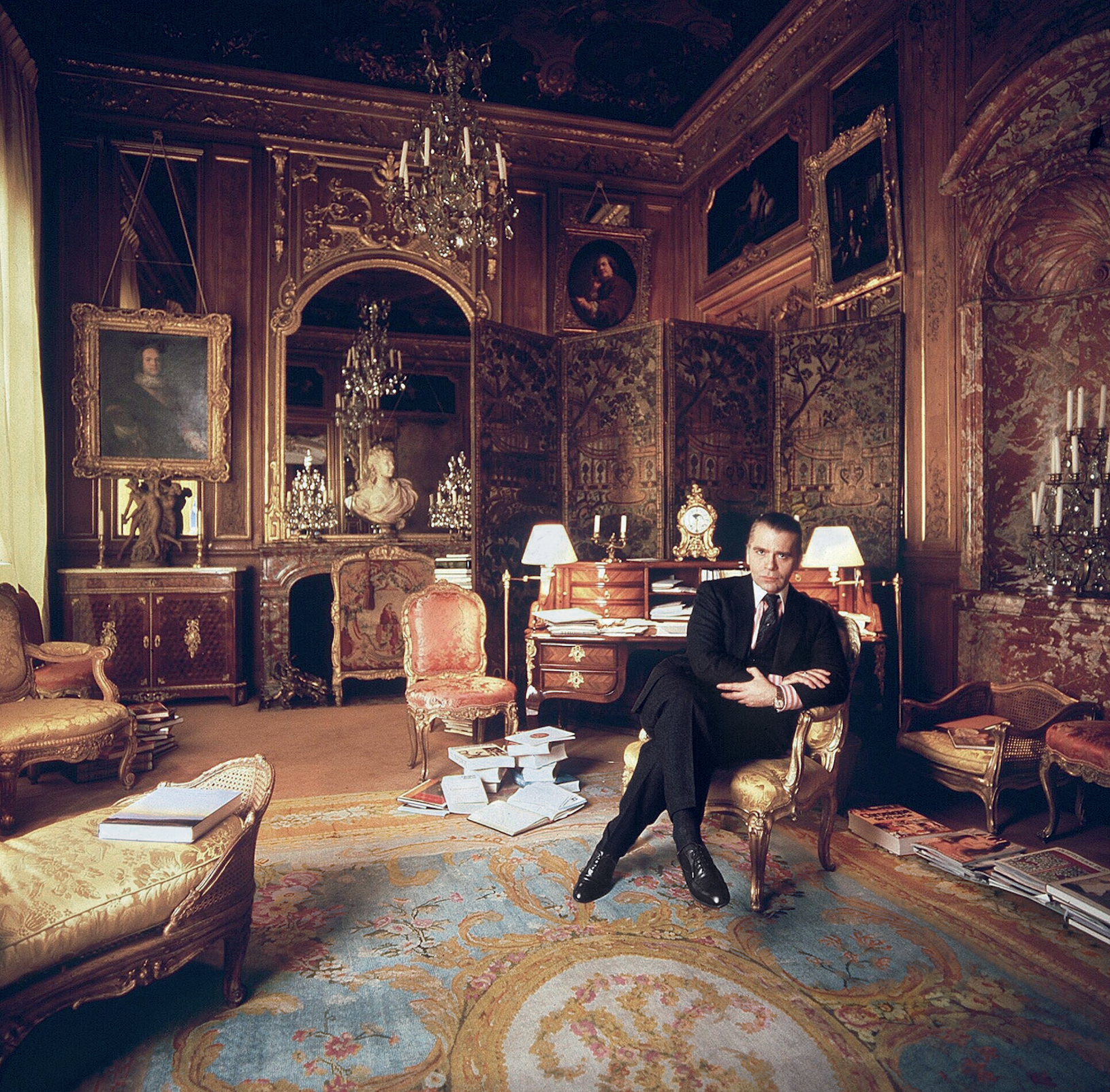
He painted the rooms milky white and lined them with specially commissioned carpets—the tawny patterned striations of which invoked musky wild animal pelts. These lent a stark relief to the sleek, machine-age chrome lines of his Deco furnishings. To contemporary eyes it remains a strikingly original arrangement that subtly conveys the tensions at play in Lagerfeld’s own life: the cocaine fuelled orgies of his lover and friends, hosted in the pristine home of a man who claimed that “a bed is for one person”.
In 1975, a painful falling out with his beloved Jacques, who was descending into the abyss of addiction, saw almost his entire collection of peerless Art Deco furniture, paintings and objects put under the auctioneer’s hammer. This was the first of many auction sales, as he habitually shed the contents of his houses along with whatever incarnation of himself had lived there. Lagerfeld was dispassionate about parting with these precious goods. “It’s collecting that’s fun, not owning,” he said. And the reality for a collector on such a Renaissance scale, is that to continue buying, Lagerfeld had to sell.
Of all his residences, it was the 1977 purchase of Hôtel Pozzo di Borgo, a grand and beautifully preserved 18th-century house, that would finally allow him to fulfill his childhood fantasies of life in the court of Madame de Pompadour. And it was in this aura of Rococó splendour that the fashion designer began to affect, along with his tailored three-piece suits, a courtier’s ponytailed and powdered coif and a coquettish antique fan: marking the beginning of his transformation into a living, breathing global brand that even those with little interest in fashion would immediately recognise.
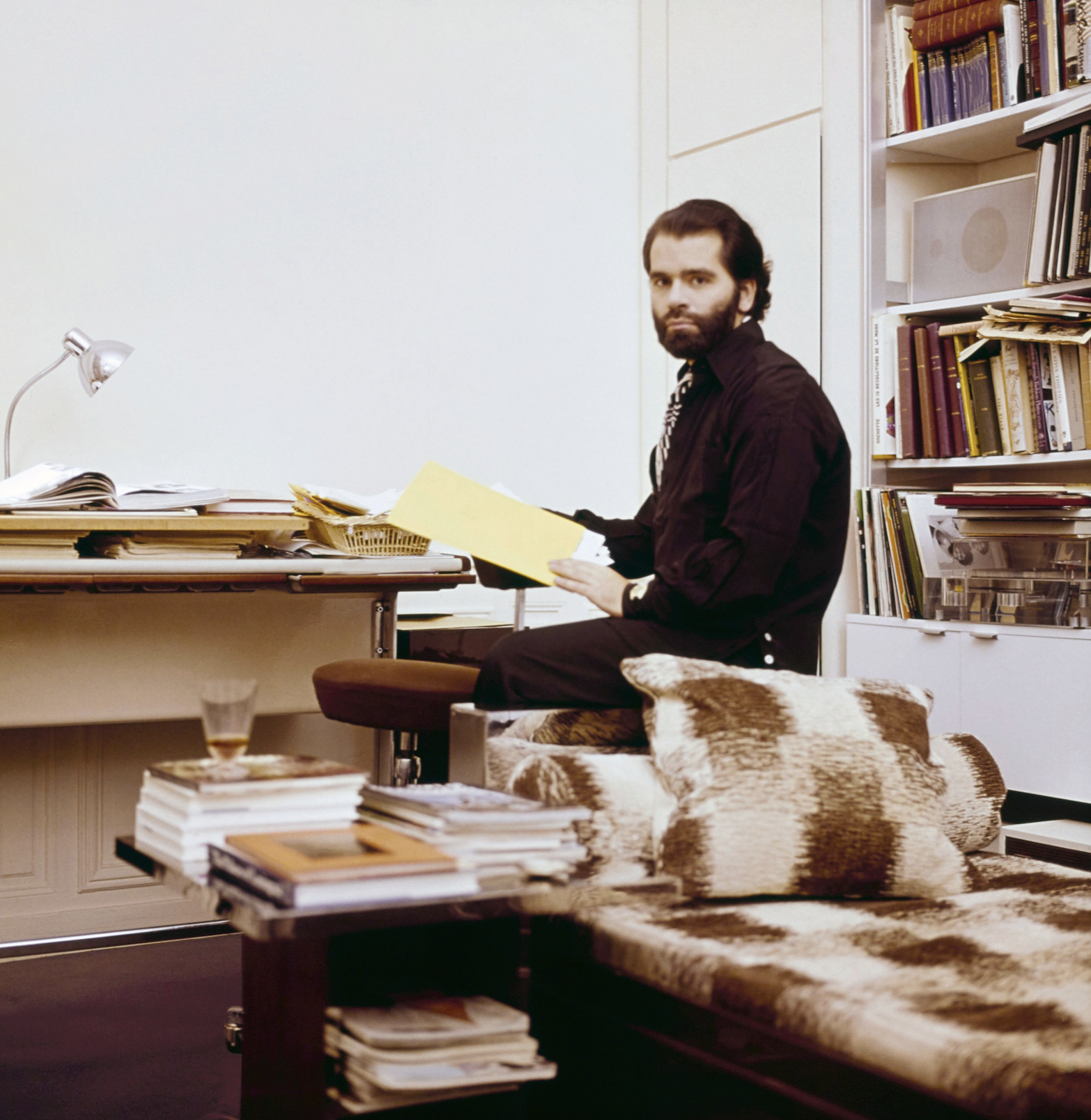
Lagerfeld’s increasing fame and financial success allowed him to indulge in an unprecedented spending frenzy, competing with deep-pocketed institutions like the Louvre to acquire the finest, most pedigreed pearls of the era—voluptuously carved and gilded bergères; ormolu chests; and fleshy, pastel-tinged Fragonard idylls—to adorn his urban palace. His one-time friend André Leon Talley described him in a contemporary article as suffering from “Versailles complex”.
However, in mid-1981, and in response to the election of left-wing president, François Mitterrand, Lagerfeld, with the assistance of his close friend Princess Caroline, became a resident of the tax haven of Monaco. He purchased two apartments on the 21st floor of Le Roccabella, a luxury residential block designed by Gio Ponti. One, in which he kept Jacques de Bascher, with whom he was now reconciled, was decorated in the strict, monochromatic Viennese Secessionist style that had long underpinned his aesthetic vocabulary; the other space, though, was something else entirely, cementing his notoriety as an iconoclastic tastemaker.

Lagerfeld had recently discovered the radically quirky designs of the Memphis Group led by Ettore Sottsass, and bought the collective’s entire first collection and had it shipped to Monaco. In a space with no right angles, these chaotically colourful, geometrically askew pieces—centred on Masanori Umeda’s famous boxing ring—gave visitors the disorientating sensation of having entered a corporeal comic strip. By 1991, the novelty of this jarring postmodern playhouse had inevitably worn thin and once again he sent it all to auction, later telling a journalist that “after a few years it was like living in an old Courrèges. Ha!”
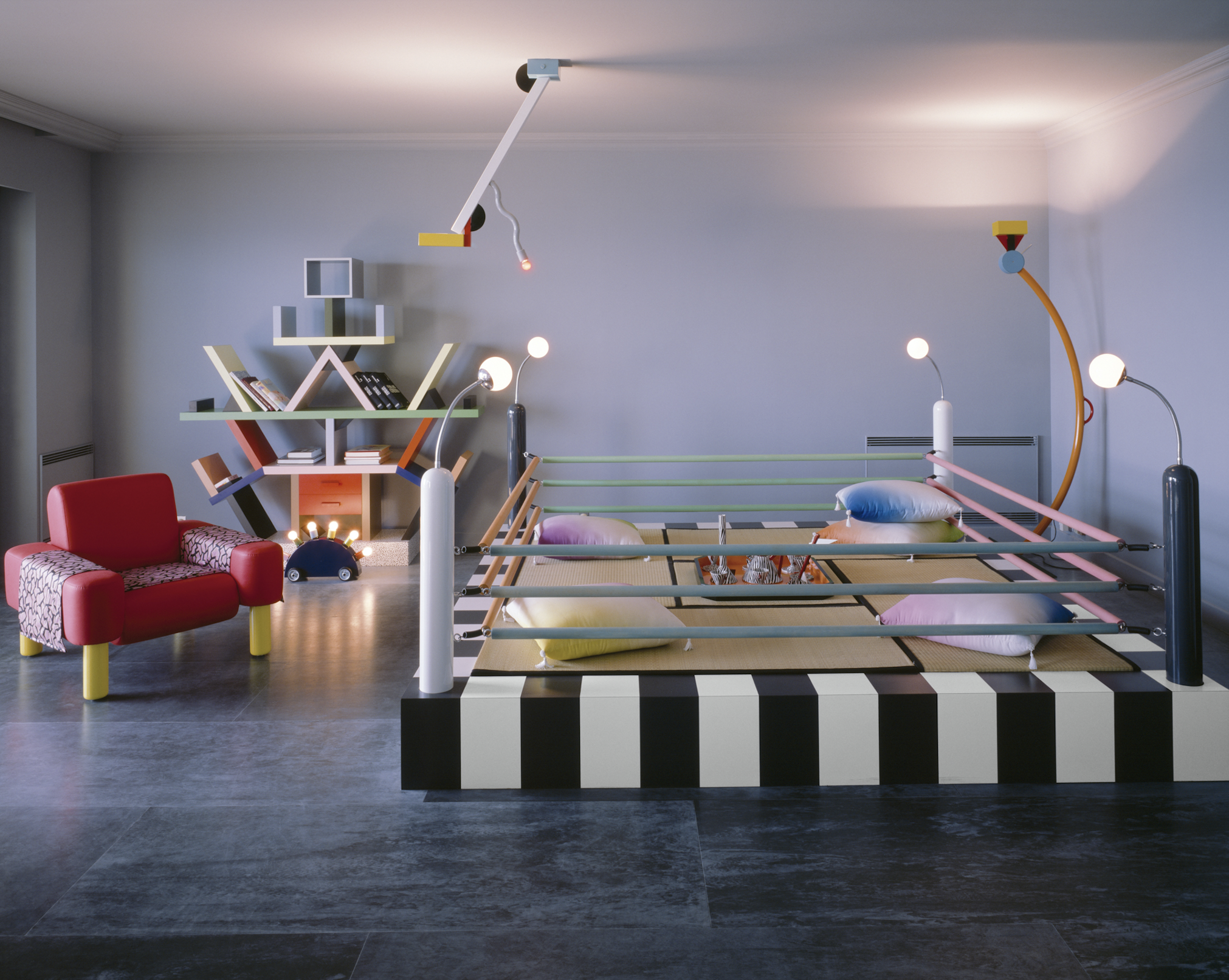
In 1989, de Bascher died of an AIDS-related illness, and while Lagerfeld’s career continued to flourish, emotionally the famously stoic designer was struggling. In 2000, a somewhat corpulent Lagerfeld officially ended his “let them eat cake” years at the Hôtel Pozzo di Borgo, selling its sumptuous antique fittings in a massive headline auction that stretched over three days. As always there were other houses, but now with his longtime companion dead, and his celebrity metastasising making him a target for the paparazzi, he began to look less for exhibition spaces and more for private sanctuaries where he could pursue his endless, often lonely, work.
His next significant house was Villa Jako, named for his lost companion and built in the 1920s in a nouveau riche area of Hamburg close to where he grew up. Lagerfeld shot the advertising campaign for Lagerfeld Jako there—a fragrance created in memorial to de Bascher. The house featured a collection of mainly Scandinavian antiques, marking the aesthetic cusp between Art Nouveau and Art Deco. One of its rooms Lagerfeld decorated based on his remembrances of his childhood nursery. Here, he locked himself away to work—tellingly—on a series of illustrations for the fairy tale, The Emperor’s New Clothes. Villa Jako was a house of deep nostalgia and mourning.
But there were more acts—and more houses—to come in Lagerfeld’s life yet. In November 2000, upon seeing the attenuated tailoring of Hedi Slimane, then head of menswear at Christian Dior, the 135 kg Lagerfeld embarked on a strict dietary regime. Over the next 13 months, he melted into a shadow of his former self. It is this incarnation of Lagerfeld—high white starched collars; Slimane’s skintight suits, and fingerless leather gloves revealing hands bedecked with heavy silver rings—that is immediately recognisable some five years after his death.
The 200-year-old apartment in Quái Voltaire, Paris, was purchased in 2006, and after years of slumber Lagerfeld—a newly awakened Hip Van Winkle—was ready to remake it into his last modernist masterpiece. He designed a unique daylight simulation system that meant the monochromatic space was completely without shadows—and without memory. The walls were frosted and smoked glass, the floors concrete and silicone; and any hint of texture was banned with only shiny, sleek pieces by Marc Newson, Martin Szekely and the Bouroullec Brothers permitted. Few guests were allowed into this monastic environment where Lagerfeld worked, drank endless cans of Diet Coke and communed with Choupette, his beloved Birman cat, and parts of his collection of 300,000 books—one of the largest private collections in the world.

Lagerfeld died in 2019, and the process of dispersing his worldly goods is still ongoing. The Quái Voltaire apartment was sold this year for US$10.8 million (around $16.3 million). Now only the rue de Saint-Peres property remains within the Lagerfeld trust. Purchased after Quái Voltaire to further accommodate more of his books—35,000 were displayed in his studio alone, always stacked horizontally so he could read the titles without straining his neck—and as a place for food preparation as he loathed his primary living space having any trace of cooking smells. Today, the rue de Saint-Peres residence is open to the public as an arts performance space and most fittingly, a library.
You may also like.
By Josh Bozin
24/07/2024
Watch This Space: Mike Nouveau
Meet the game-changing horological influencers blazing a trail across social media—and doing things their own way.
In the thriving world of luxury watches, few people own a space that offers unfiltered digital amplification. And that’s precisely what makes the likes of Brynn Wallner, Teddy Baldassarre, Mike Nouveau and Justin Hast so compelling.
These thought-provoking digital crusaders are now paving the way for the story of watches to be told, and shown, in a new light. Speaking to thousands of followers on the daily—mainly via TikTok, Instagram and YouTube—these progressive commentators represent the new guard of watch pundits. And they’re swaying the opinions, and dollars, of the up-and-coming generations who now represent the target consumer of this booming sector.
—
MIKE NOUVEAU
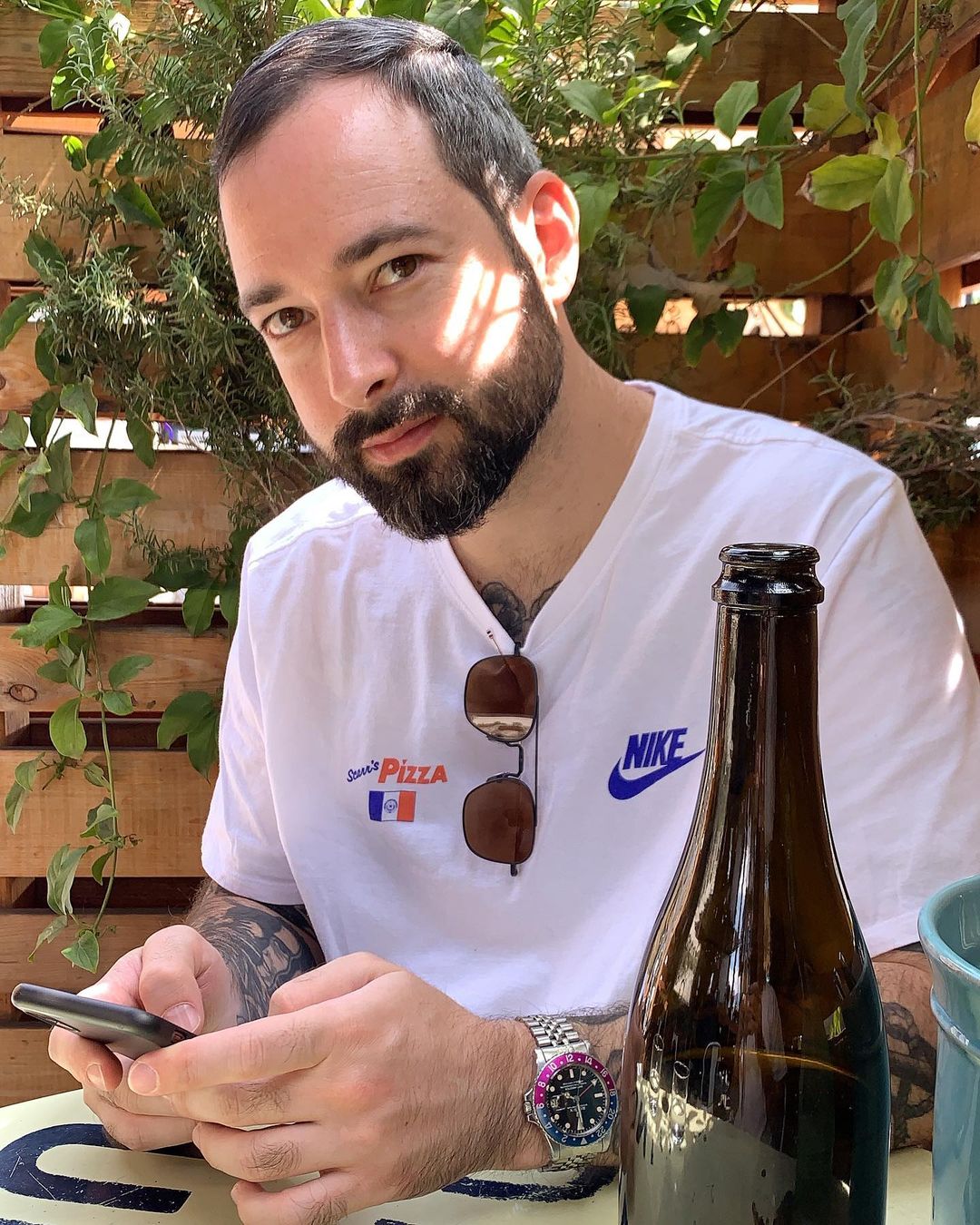
Can we please see what’s on the wrist? That’s the question that catapulted Mike Nouveau into watch stardom, thanks to his penchant for highlighting incredibly rare timepieces across his TikTok account of more than 400,000 followers. When viewing Nouveau’s attention-grabbing video clips—usually shot in a New York City neighbourhood—it’s not uncommon to find him wrist-rolling some of the world’s rarest timepieces, like the million-dollar Cartier Cheich (a clip he posted in May).
But how did someone without any previous watch experience come to amass such a cult following, and in the process gain access to some of the world’s most coveted timepieces? Nouveau admits had been a collector for many years, but moved didn’t move into horology full-time until 2020, when he swapped his DJing career for one as a vintage watch specialist.
“I probably researched for a year before I even bought my first watch,” says Nouveau, alluding to his Rolex GMT Master “Pepsi” ref. 1675 from 1967, a lionised timepiece in the vintage cosmos. “I would see deals arise that I knew were very good, but they weren’t necessarily watches that I wanted to buy myself. I eventually started buying and selling, flipping just for fun because I knew how to spot a good deal.”
Nouveau claims that before launching his TikTok account in the wake of Covid-19, no one in the watch community knew he existed. “There really wasn’t much watch content, if any, on TikTok before I started posting, especially talking about vintage watches. There’s still not that many voices for vintage watches, period,” says Nouveau. “It just so happens that my audience probably skews younger, and I’d say there are just as many young people interested in vintage watches as there are in modern watches.”
View this post on Instagram
Nouveau recently posted a video to his TikTok account revealing that the average price of a watch purchased by Gen Z is now almost US$11,000 (around $16,500), with 41 percent of them coming into possession of a luxury watch in the past 12 months.
“Do as much independent research as you can [when buying],” he advises. “The more you do, the more informed you are and the less likely you are to make a mistake. And don’t bring modern watch expectations to the vintage world because it’s very different. People say, ‘buy the dealer’, but I don’t do that. I trust myself and myself only.”
—
Read more about the influencers shaking up horology here with Justin Hast, Brynn Wallner and Teddy Baldassare.
You may also like.
By Josh Bozin
24/07/2024
This Pristine 1960 Ferrari 250 Spider Could Fetch $24 Million at Auction
The car wears the same colours and has the same engine it left the factory with.
Some Ferraris are just a little bit more important than others.
Take, for example, the 1960 250 GT SWB California that RM Sotheby’s is auctioning off during this year’s Monterey Car Week. Any example of the open-top beauty would attract interest, but this one just so happens to be the first one that was built.
The 250 is one of the most legendary series of cars in Ferrari history. Between 1952 and 1964, the company released 21 different 250 models—seven for racetracks, 14 for public roads—of which the “Cali Spider” might be the most well regarded, thanks to its potent V-12 and a Pininfarina-penned design that is one of the most beautiful bodies to grace an automobile. The roadster, which was specifically built for the U.S., made its debut in 1957 as a long-wheel-base model (LWB), but it wasn’t until the SWB model debut in 1960 that it became clear how special it was. This example isn’t just the first to roll off the line. It’s the actual car that was used to introduce the world to the model at the 1960 Geneva Motor Show.

Just 56 examples of the 250 GT SWB California Spider would be built by Scaglietti during the three years it was in production. The first of those, chassis 1795 GT, is finished in a glossy coat of Grigio. The two-door had a red leather interior at Geneva but was returned to the factory and re-outfitted with black leather upholstery before being delivered to its original owner, British race car driver John Gordon Bennet. Six-and-a-half decades later the car looks identical to how it did when it left the factory the second time.
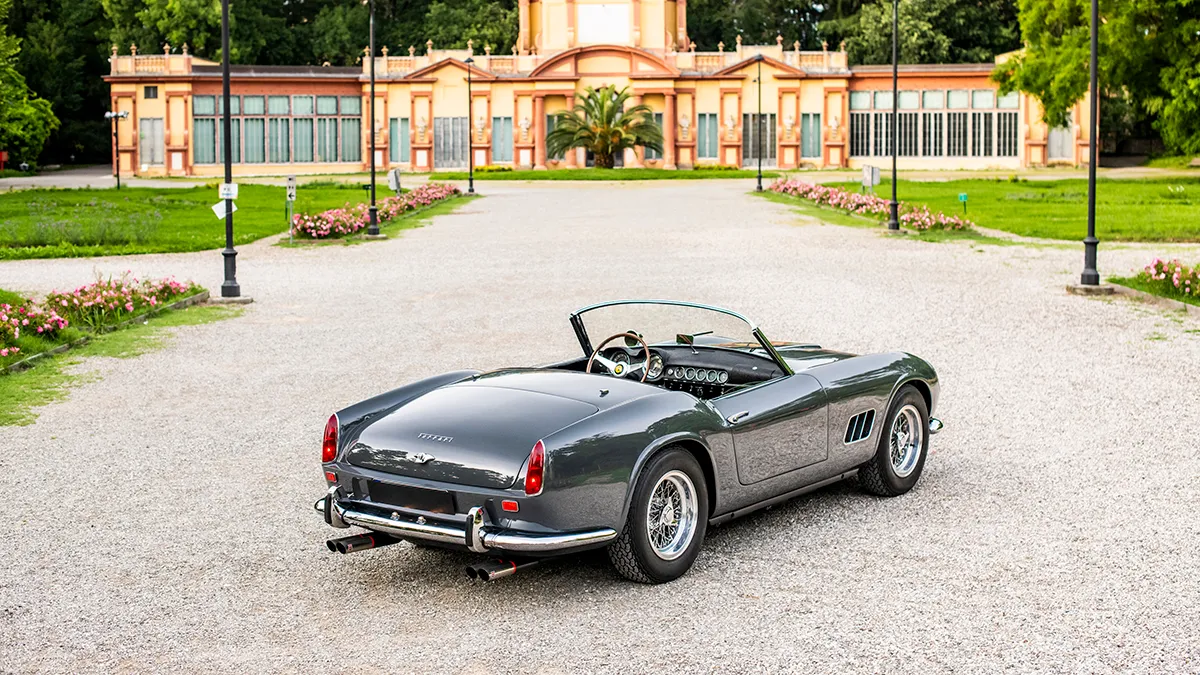
In addition to its original bodywork, the chassis 1795 GT features its original engine, gearbox, and rear axle. That mill is the competition-spec Tipo 168, a 3.0-litre V-12 that makes 196.1 kW. That may not sound like much by today’s standards, but, when you consider that the 250 GT SWB California Spider tips the scales around 952 kilograms, it’s more than enough.
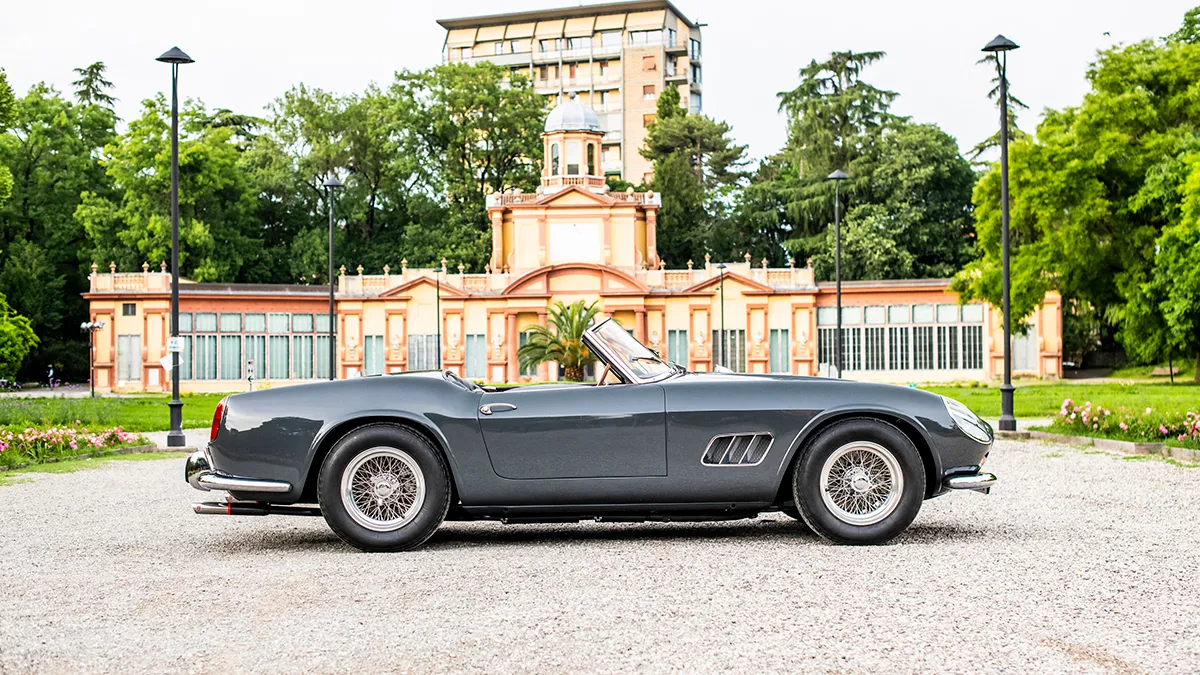
The first 250 GT SWB California Spider is scheduled to go up for bid during RM Sotheby’s annual Monterey Car Week auction, which runs from Thursday, August 15, to Saturday, August 17. Unsurprisingly, the house has quite high hopes for the car. The car carries an estimate of between $24 million and $26 million, which could make it one of the most expensive cars ever sold at auction.

You may also like.
By Josh Bozin
24/07/2024








